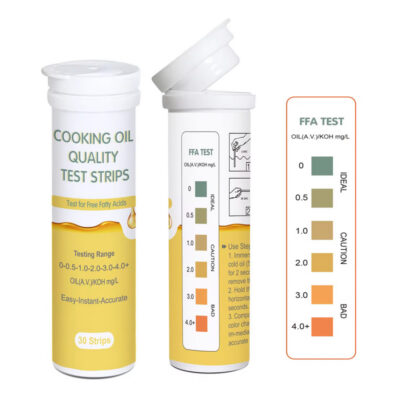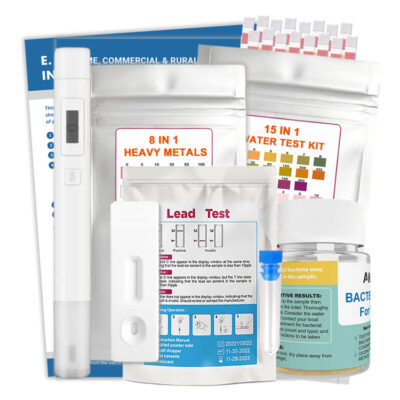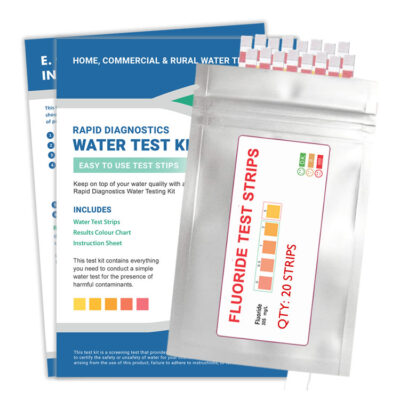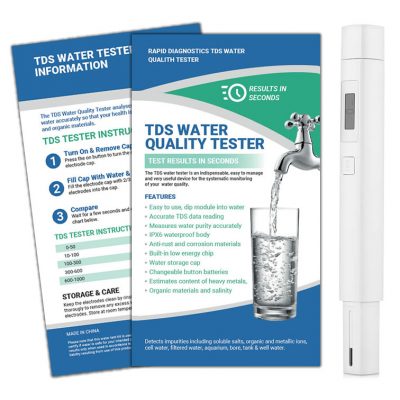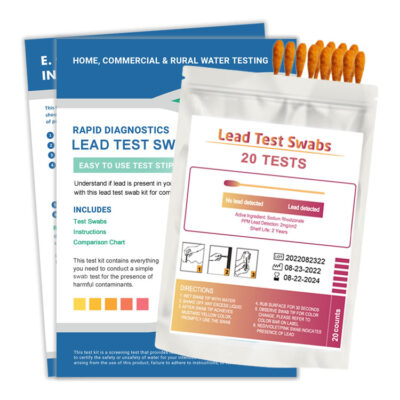Nitrate or Nitrite Test Kits help to determine the levels of Nitrite in your drinking water which refers to nitrogen and oxygen levels which can also be described as salt. Our 14 in 1 Nitrate Test Kit detects Nitrate from 10 mg/L to 300 mg/L and Nitrite 5 mg/L to 80 mg/L.

Where does nitrate come from
Nitrate is made from a verity of natural resources including fertilisers, detergents, industrial chemicals, sewage, animal waste and plants that have decomposed in a process called nitrification, first forming ammonia, then nitrites and then nitrates.
Low Levels of nitrate
Nitrate is a water soluble compound that is tasteless, odorless and colourless. It is found naturally in water and is not harmful at low levels. It is an essential protein or amino acid that helps with plant and animal growth.
High Levels of nitrate
Excessive amounts which are not used up by plants are classified as pollutants which leach through your soil into ground water. High levels can cause eutrophication which is when too many minerals and nutrients get into your water causing excessive plant growth and algae. This takes oxygen from water which is harmful to aquatic life and drinking water that has high levels of nitrate can seriously degrade your water quality which is harmful to human health.
How can nitrate affect my health
The EPA suggests for the safety of drinking water, the maximum contaminant level of nitrate is 10 mg/L or 10 parts per million. Nitrate levels higher than this can cause serious problems to human health. Infants drinking high levels can cause blue baby syndrome," a condition caused by lack of oxygen in infants. Current research suggests that long term exposure can also cause cancer,
People can be casually exposed to nitrate by digesting contaminated water or food. Healthy adults and older teens can ingest nitrate naturally through urine though exposure in large quantities is not usually associated with short-term effects.
Younger infants however are extremely sensitive to nitrate poisoning which can result in serious illness which occurs when nitrate is converted to nitrite in an infant’s body.
In infants, within a matter of days, Nitrite poisoning is known to reduce oxygen in the blood causing shortness of breath and blueness of the skin, hence the name “blue baby syndrome or methemoglobinemia.
In healthy adults, a lifetime of high exposure to nitrates and nitirites can case cause the following effects:
- Diuresis
- Increased starchy deposits
- Haemorrhaging of the spleen
Testing your water for nitrate and nitrite
Measuring with Nitrate or Nitrite Test Kits can reveal a lot about the health of your drinking water. Nitrate testing kits are inexpensive and help you to ascertain the natural levels while identifying if there are any pollutants entering into your drinking water.
What if nitrate is found in my water?
If nitrate levels exceeds acceptable levels, do not drink the water be ultra-cautious that children under the age of 6 do not drink it as they are more susceptible to sickness compared to health adults.
- Boiling water with high levels of nitrate will not treat the problem.
- Use bottle water to meet your daily requirements.
- Reverse osmosis water filters can be used to remove nitrates from your drinking water though this should be used as a temporary measure, the issue should be resolved as a reverse osmosis water filter cannot guarantee that it removes all traces of the contaminant.
- Further advise should be sought by a certified water quality tester. You can also contact water testing laboratories which will provide you with sampling bottles and instructions to follow.
- When you do identify the pollutant source, have it repaired to prevent further or future contamination of your drinking water.
- Once the source of the pollutant has been rectified, it’s wise to regularly test your nitrate levels 4-5 times a year.
Removing Nirtrite From Your Drinking Water
Although the following can help to remove nitirite from your drinking water, if identified these should be used as temporary measures. The source of contamination should be rectified as some of the following suggestions can not guarantee that they removes all traces of the nitrite.
Distillation
This process involves heating your contaminated water to boiling point, collecting and condensing the steam by means of a metal rod. Most of the nitrite contamination can be removed by this process making your water safer to drink. Just boiling your water will not resolve the issue, it will make the problem worse as the nitrate will form a concentrate. Clean water is achieved y collecting and condensing the steam that is generated when water is boiled. Specialised equipment should be purchased for distillation of contaminated water.
Reverse Osmosis
Reverse Osmosis is a process of pressurising your water forcing it through a semi-permeable membrane. As the water passes through the membrane filters out most of the contaminants. Manufacturers of reverse osmosis water filtration systems suggest that 85 to 95% of contaminants can be removed. The actual outcome will vary depending on your water quality and the units pressure.

